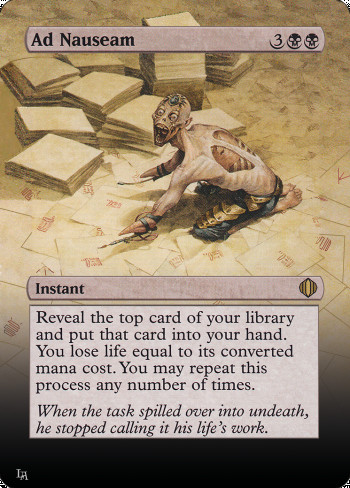
Abzan Farm - Tymna Ikra Turbo Nauseam
Commander / EDH BGW (Abzan, Junk) Combo Competitive Infinite Combo Lifegain Multiplayer
Land (29)
-
1x
Ancient Tomb

- 1x Arid Mesa
- 1x Bayou
-
1x
Bloodstained Mire

-
1x
Boseiju, Who Shelters All

- 1x Cavern of Souls
-
1x
Command Tower

-
1x
Emergence Zone

-
1x
Exotic Orchard

-
1x
Flooded Strand

-
1x
Forest


- 1x Gaea's Cradle
-
1x
Gemstone Caverns

-
1x
Godless Shrine

- 1x Marsh Flats
- 1x Misty Rainforest
-
1x
Overgrown Tomb

- 1x Phyrexian Tower
-
1x
Polluted Delta

- 1x Savannah
-
1x
Scavenger Grounds

- 1x Scrubland
-
1x
Snow-Covered Forest

-
1x
Snow-Covered Plains

-
1x
Snow-Covered Swamp

-
1x
Temple Garden

- 1x Verdant Catacombs
-
1x
Windswept Heath

-
1x
Wooded Foothills

Enchantment (10)
Creature (18)
-
1x
Avacyn's Pilgrim

-
1x
Blood Pet

-
1x
Children of Korlis

-
1x
Corpse Knight

-
1x
Dark Confidant

-
1x
Deathrite Shaman

-
1x
Elves of Deep Shadow

- 1x Elvish Spirit Guide
-
1x
Grand Abolisher

-
1x
Hope of Ghirapur

-
1x
Krosan Wayfarer

-
1x
Leonin Relic-Warder

-
1x
Memnite

-
1x
Overeager Apprentice

-
1x
Ranger-Captain of Eos

-
1x
Serra Ascendant

-
1x
Thieves' Guild Enforcer

-
1x
Weathered Wayfarer

Instant (16)
-
1x
Abrupt Decay

-
1x
Ad Nauseam


-
1x
Angel's Grace

-
1x
Assassin's Trophy

-
1x
Cabal Ritual

- 1x Crop Rotation
- 1x Culling the Weak
-
1x
Dark Ritual

-
1x
Enlightened Tutor

-
1x
Nature's Claim

-
1x
Noxious Revival

- 1x Rain of Filth
-
1x
Silence

-
1x
Tainted Pact

-
1x
Vampiric Tutor

-
1x
Veil of Summer

Sorcery (10)
Commanders (2)
Artifact (15)
Suggestions
Updates Add
Comments
Attention! Complete Comment Tutorial! This annoying message will go away once you do!
Important! Formatting tips — Comment Tutorial — markdown syntax
Please login to comment
Revision 16 See all
(4 years ago)
| -1 | Arbor Elf | main |
| +1 | Blood Pet | main |
| -1 | Cabal Therapist | main |
| +1 | Emergence Zone | main |
| +1 | Exotic Orchard | main |
| +1 | Fellwar Stone | main |
| -1 | Kenrith's Transformation | main |
| -1 | Nature's Lore | main |
| +1 | Overeager Apprentice | main |
| +1 | Peer into the Abyss | main |
| -1 | Prismatic Vista | main |
| -1 | Smuggler's Copter | main |
| -1 | Stonecoil Serpent | main |
| +1 | Thieves' Guild Enforcer | main |
| -1 | Three Visits | main |
| +1 | Weathered Wayfarer | main |
| Top Ranked |
|
| Date added | 6 years |
| Last updated | 3 years |
| Legality | This deck is not Commander / EDH legal. |
| Rarity (main - side) | 15 - 0 Mythic Rares 48 - 0 Rares 20 - 0 Uncommons 13 - 0 Commons |
| Cards | 100 |
| Avg. CMC | 1.70 |
| Tokens | Squirrel 1/1 G, Treasure |
| Folders | Commander deck ideas, Commander, stuff, cedh, cEDH, Commander ideas, Decks for Reference, Neat, cEDH Library, Deck References |
| Votes | |
| Ignored suggestions | |
| Shared with | |
| Views |










